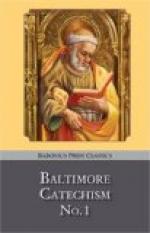“Pentecost” means the fiftieth day, because the feast comes fifty days after the resurrection of Our Lord. After His resurrection He remained forty days upon earth, and ten days after He ascended into Heaven the Holy Ghost came, thus making the fifty days.
After the Holy Ghost came down upon the Apostles they were no longer timid men. They went forth boldly into the streets and preached Christ crucified, telling the people how the Son of God—the true Messias promised—had been put to death. Many who heard them believed and were baptized. The first time St. Peter preached to the people three thousand were converted (Acts 2:41); so that when all the Apostles preached the number of Christians increased rapidly, and the Christian religion was soon carried to distant parts of the world.
At the time Our Lord was put to death the Jews were celebrating a great feast in Jerusalem. The Jews were not like us in this respect. We have many churches, and in all of them sacrifice, that is, the Holy Mass, is offered. The Jews had only one temple where sacrifice could be offered, and that was in Jerusalem. They had synagogues or meeting houses throughout the land in which they assembled to pray and hear the Holy Scriptures read; but they could not offer sacrifice in them. Three times a year they went to Jerusalem to celebrate their great feasts. One of these feasts was called the Pasch, or Passover, and it was during the celebration of that feast that Our Lord was put to death; so that there were many persons from all parts of the nation present at the sad execution. I must now tell you why they celebrated the Pasch. We generally celebrate a feast to commemorate—to remind us of—some great event; and the Jews celebrated this feast to remind them of their deliverance from the slavery of the Egyptians, in which their ancestors had been suffering for about two hundred years. At the end of that time God sent Moses to deliver them. You should know, then, who Moses was and what he did to deliver his people, and you should know also something of the history of his people—the Israelites—and how they came to be in Egypt.
At the time I am now going to speak of the old patriarch Jacob, Abraham’s grandson, had eleven sons—for Benjamin, the twelfth son, was born afterwards—and the youngest was called Joseph. Joseph was the favorite of his father, and his brothers were jealous of him. The brothers were shepherds, and used to take their flocks to feed at a great distance from home, and did not return for a long time. One day the father sent Joseph to his brothers to see if all were well. They hated Joseph because his father loved him best; and when they saw him coming they agreed never to let him return to his father. (Gen. 37). They intended to kill him. While they were debating about how they should put him to death—he was then only sixteen years old—some merchants passed on their way to Egypt; so, instead of killing him, they sold him as a slave to the merchants.




